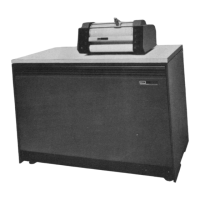General
Make-up
of
the
Subroutine
Deck
General
Make-up
of
an
Object
Deck
a
halt
instruction is executed.
The
starting instruction for
each
program
is in
location
00402. After
each
statement is processed
during
compilation,
the
pro-
gram returns to location 00462 to continue.
The
sections of
the
standard
deck, identified
by
card
number,
are
as follows:
Card
Numbers
00001
through
00044
01001 through 01054
02001
02002
through
02007
03001
through last
card
Loading
routine
and
initialization program
Object
program
loader
Number
of
included
subroutines
Names of
included
subroutines
Compiler
program
The
first section of
the
subroutine deck
is
a loading routine which loads
the
sub-
routine relocator.
The
relocator processes
the
relocatable subroutines which im-
mediately follow
it
in
the
deck
and
finally reads in
and
processes
the
arithmetic
and
input/output
subroutines
(type
1)
which
are
contained in
the
last section
of
the
deck.
The
sections of
the
standard
subroutine deck, identified
by
their first card,
are
as follows:
Card
Numbers
04001
04010
05000
06000
07000
08000
09000
26000
30000
Section
Loading
routine
Subroutine relocator
SIN
/COS
subroutine
ATAN subroutine
EXP
subroutine
LOG
subroutine
SQRT subroutine
Relocatable subroutine trailer
Arithmetic
and
input/output
subroutines
The
first two sections in the object deck
have
been
punched
during
the
initializa-
tionphase
and
consist of a
short
loading routine which loads
the
add
tables
and
the
program
and
symbol table loader.
The
cards following these contain the
compiled instructions which
are
concluded
by
a record containing only
the
constant 00509990
and
a communication card.
The
communication
card
consists
of three 5-digit fields,
the
50-digit field indicating
which
subroutines
are
being
used, followed
by
a 5-digit field indicating
the
memory
capacity.
When
executed,
the
first loading routine branches to
the
program
loader
which
loads
the
compiled
instructions
in
proper
order
into storage to form
the
object program. Following
this is
the
symbol table, as
it
appears
at
the
end
of compilation,
which
is
read
into storage
by
the
program
loader. These cards
are
read
into storage
by
the
program loader
which
expands
the
table
to allow for any dimensioned variables
which
were
used
in
the
source program.
The
next section contains any relocated
subroutines
(type
3)
which
may
have
been
called for, if
the
subroutines
were
processed
when
the
object program was compiled.
The
last section
of
the
deck contains
the
arithmetic
and
input/output
sub-
routines,
the
multiply
and add
tables,
and
the
instructions
which
cause
the
ma-
chine to
halt
before
branching
to
the
start
of
the
object program.
Analysis
of
the
FORTRAN
Program 67

